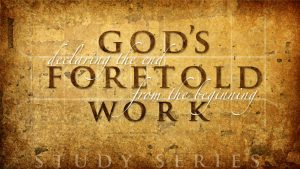Dec 12, 2007 9:13 AM,
Is there any backing to support the day of the Lord as the thousand year reign? The scripture says that a day is as a thousand years with the Lord. If that is what you just explained please excuse me.
I see nothing that makes the thousand year reign of Christ the equivalent of the ‘day of the Lord’. The millennium is not the ‘day of the Lord’, but rather follows from it. The ‘day of the Lord’ is more specific, and failure to mark its more defined character has been the source of much needless confusion and error. Let me explain.
When the particular term the ‘day of the Lord’ is expanded to include the entire millennium, or when it is extended backwards to include the entirety of the tribulation, as in pretribulational thought, something is blurred that robs the term of its great value in interpretation, as the definitive point of division between ‘this age’ and the millennial age that follows.
The scripture does, however, speak of the new circumstance that follows the ‘day of the Lord’ by the less specific phrase “in that day”. But I think it is more accurate and scriptural to distinguish the day of the Lord as the more definite and particular point of a sudden divine intervention at the end of the tribulation (“in one day” Isa 66:8; Ezek 39:22; Zech 3:9; 14:7; 2Thes 2:8). The ‘day of the Lord’ is the point of the change, and the less specific phrase ‘in that day’ is sometimes more inclusive of the conditions that follow from it. This, however, is not a distinction I would expect everyone to make, and I do not regard it as critical. But more specifically, and far more importantly, the day of the Lord marks the sudden destruction of the Antichrist (2Thes 2:8), which is also the moment of Israel’s national deliverance at the end of Jacob’s trouble (Jer 30:7; Dan 12:1). It is the time that the OT faithful are raised together with all who “sleep in Jesus” (Dan 12:2; 1Thes 4:14-17; 1Cor 15:23). It is the ‘moment’ Christ’s glorious return “at the last trump” (compare Isa 27:13; Mt 24:31; 1Thes 4:16; 2Thes 2:8; 1Cor 15:52; Rev 11:15). It all happens at once.
Whether the ‘day of the Lord’ includes the millennium does not seem to me a crucial point of concern. However, to extend the ‘day of the Lord’ backwards to include the tribulation supports a serious error. I’ll explain.
The view that the rapture starts the day of the Lord, and that the day of the Lord therefore includes the tribulation, did not exist before the advent of the system of prophetic interpretation called “pretibulational – dispensationalism” that took root in the middle of the 19 th century.
Because the ‘day of the Lord’ is so obviously related to the ‘blessed hope’ of the church (1Thes 5:4; 2Thes 2Thes 1:7 et al), it was impossible to maintain the idea that the rapture could potentially occur any moment UNLESS the ‘day of the Lord’ could be understood to include the tribulation. There is no scripture to that effect, but to maintain the theory of a pre-trib rapture, this re-location of the day of the Lord was considered a “necessary inference”. I know that sounds confusing, because it is. It is a violation of the simplicity of scripture that places the ‘day of the Lord’ AFTER the tribulation. Let me show you why this is so important, and then you can help show someone else, should the question arise.
Many scriptures could be cited in both of the testaments to show that the day of the Lord does not include the tribulation but rather concludes it (see for example Rev 16:15 where the thief like return of the Lord is shown as still impending even so late as the sixth vial. The seventh vial then announces the arrival of “the great day of God”). But I know of no better example than Joel’s prophecy, particularly when it is compared with the Lord’s words in His Olivet prophecy. Listen to the language of the following scriptures, and note the key prepositions BEFORE and AFTER.
“And I will show wonders in the heavens and in the earth, blood, and fire, and pillars of smoke. The sun shall be turned into darkness, and the moon into blood, BEFORE the great and the terrible day of the Lord come. And it shall come to pass, that whosoever shall call on the name of the Lord shall be delivered: for in mount Zion and in Jerusalem shall be deliverance, as the Lord hath said, and in the remnant whom the Lord shall call” (Joel 2:30-32). “Put ye in the sickle, for the harvest is ripe: come, get you down; for the press is full, the fats overflow; for their wickedness is great. Multitudes, multitudes in the valley of decision: for the day of the Lord is NEAR (at hand; approaching, but not yet here) in the valley of decision. The sun and the moon shall be darkened, and the stars shall withdraw their shining. The Lord also shall roar out of Zion, and utter his voice from Jerusalem; and the heavens and the earth shall shake: but the Lord will be the hope of his people, and the strength of the children of Israel” (Joel 3:13-16).
The same is quoted by Peter in Acts 2:20. “The sun shall be turned into darkness, and the moon into blood, BEFORE that great and notable day of the Lord come”
But now listen to Jesus:
“Immediately AFTER the tribulation of those days shall the sun be darkened, and the moon shall not give her light, and the stars shall fall from heaven, and the powers of the heavens shall be shaken: And then shall appear the sign of the Son of man in heaven: and then shall all the tribes of the earth mourn, and they shall see the Son of man coming in the clouds of heaven with power and great glory” (Mt 24:29-30).
Note that Jesus places the stellar upheaval and eclipse immediately AFTER the tribulation, whereas Joel’s prophecy shows this as happening BEFORE the great and notable ‘day of the Lord’. How then can the day of the Lord be held to include the tribulation if the darkness that comes BEFORE the day of the Lord is said by Jesus to come ‘immediately AFTER’ the tribulation? It simply cannot be done; scripture doesn’t permit it. But it must be done if pre-tribulationism is to survive.
Many have shown that to place the ‘day of the Lord’ AFTER the tribulation is FATAL to the pre-trib theory. In fact, the comparatively recent habit of placing the ‘day of the Lord’ before the tribulation was unheard of until after Alexander Reese, a missionary from New Zealand, wrote a book called “The Approaching Advent of Christ: An Examination of the teaching of J.N. Darby and his Followers,” published in 1937. Reese’s book forced dispensationalists (those that advocate the pre-trib view of the rapture), to change their earlier view of a ‘post-tribulational’ day of the Lord. Henceforward, dispensationalists would place the ‘day of the Lord’ at the beginning of the tribulation. (Also in response to Reese’s book, pretribulationists were now forced to ‘assume’ a new separation between an earlier resurrection of “church saints” (considered as belonging to a separate body) and the resurrection of the OT faithful, which Reese showed to everyone’s admission to occur AFTER the tribulation (compare Isa 25:8: 26:19; Dan 12:2, 13).
So, according to this novel view, the OT saints are not raised at the rapture, but seven years later when Christ comes to establish His millennial rule over the nations. Astonishing, isn’t it? See what a war has been raging over these things? But what is the real significance of so much confusion? Before we despair of certainty, and resign everything over to the hopelessly disagreed prophecy experts, let us first consider whether our enemy has a vested interest in fomenting such confusion in order to keep these issues hidden from the church, and to discourage the average believer from trusting in the grace of the Spirit’s help to arrive at the truth (the much neglected priesthood of every believer; 1Jn 2:27). These matters have the potential to become very determinative of a great deal. A lie always costs; and this one in particular threatens to exact an ominous toll.
Later, another significant book was written in 1973 by Robert Gundry: “The Church and the Tribulation.” Gundry exposed the impossibility of starting the ‘day of the Lord’ with the pre-tribulational rapture, because the rapture, as taught in the pre-tribulational scheme, must be an “imminent” (un-signaled) event that can potentially occur any moment. Gundry proved that this is impossible; because Paul shows clearly that the “day of the Lord” CANNOT come EXCEPT the ‘Man of Sin’ is first revealed (2Thes 2:1-3). Obviously, the ‘day of the Lord’ is not an ‘imminent’ event in Paul’s eschatology. So what were the pre-tribulationists to do? Well, they would invent yet another gap. After Gundry, the rapture would be seen as happening sometime further back BEFORE the beginning of the ‘day of the Lord’ in order to allow time for the prior revelation of the ‘man of sin’. That’s the new solution proposed to circumvent Gundry’s otherwise decisive argument. There’s no standard position on how long this new gap should last.
All of this goes to show the confusion that comes by a mis-location of the ‘day of the Lord’, and thus, the disarming loss of its safeguarding simplicity. So I am less concerned with whether one includes the millennium as part of the ‘day of the Lord’, as I am with the errors that follow when the day of the Lord is understood to include the tribulation. A right view of the ‘day of the Lord’ and its relationship to the basic events of prophecy goes further than anything else I know towards establishing the right order of events, and thus avoiding many a needless confusion. I pray that we will come to a greater clarity on this for all of these reasons and more, as the ‘day of the Lord’ is also a central issue in the replacement debate as well. Hope this contributes to a better understanding. I wish I had the time to be more thorough and clear, but this may help you be on the look out for some of these issues as they come up in your own study.
Yours in the Beloved, Reggie




